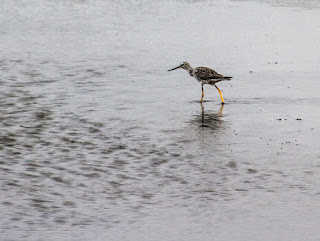Brazoria National Wildlife Refuge
One day, we decided to drive around and explore to see if we
could find a wildlife refuge that my reference book for bird sightings
mentioned. At times, we thought we had
gotten lost, but eventually, we did find the refuge and the treasures that live
within.
Although most of the refuge was geared toward an auto tour, the first part of the refuge had a boardwalk over some marshy lands. This marsh was home to several types of birds, one of which was this black cormorant. I must admit, I was mesmerized watching this little guy glide thru the marshy water and plant debris, without getting any on his wings or body!
I should have known better, but I allowed myself to forget that there could be alligators around in these waters. My reminder came in the form of a nest of baby gators (top photo), Mama Gator hanging around (bottom left photo), and another little guy who just decided to strike a pose for us (lower right photo).
As we continued our drive, we did see an ibis flying over a lake in the refuge. It was a rather shallow lake, so maybe calling it a pond might be more accurate! I really love his long beak, easier for him to seek out his meals.
A bit further down we saw an anhinga drying his wings. Anhingas fish by diving into bodies of water to swim after their food. When they surface, they strike this somewhat unique pose to allow them to dry their wings fairly quickly, so they can again take to the air.
Another shore bird we saw wading through the very shallow waters of some parts of the marshy refuge was the whimbrel. It is in the sandpiper family, and its name originated in England, and sort of sounds like its call. It didn’t call when we saw him, so I can’t verify that!
Here was a rare find (for us!) – a tri-colored heron. This bird used to be known as Louisiana heron, and although solitary in its feeding habits, when it nests, it does tend to be social and can often be found in colonies with other herons and egrets, who are part of its family.
And, finally, we saw a snowy egret. I did manage to get somewhat of a close-up of him, but then, he took off in the awkward way of egrets and herons. Once in the air, they do strike quite the graceful pose.
I’m ending this post with another image of the snowy egret. I loved how peaceful he looked as he glided over the marshy refuge, his white feathers contrasted by the brownish gold grasses, not yet green in the early spring. You can see the silhouette of taller trees in the background.
Enjoy!








No comments:
Post a Comment